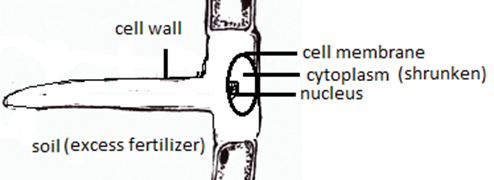The diagram below represents a layer of epidermal cells showing a fully grown root hair.
Study the diagram and answer the questions that follow:

(b) The root hair cell is in a turgid state. Name and explain the process that caused this state.
(c) Mention one distinct difference between the parts labeled A and B.
(d) Draw a diagram of the above root hair cell as it would appear when a concentrated solution of fertilizers is added near it.
(b) The root hair cell is turgid because of the endosmosis of water from its surrounding soil.
Endosmosis is the inward diffusion of water through a semi-permeable membrane when the surrounding solution is less concentrated. This leads to the swelling up of the cells and thus becomes turgid.
(c) The part labeled “A” is the cell wall.
The part labeled “B” is cell membrane.
The differences between the cell wall and cell membrane are:

(d) When a concentrated solution of fertilizer is added near the root hair cell it undergoes exosmosis and thus gets plasmolysed.
